The Durometer Market is estimated to be valued at USD 1.3 billion in 2025 and is projected to reach USD 2.2 billion by 2035, registering a compound annual growth rate (CAGR) of 5.5% over the forecast period.
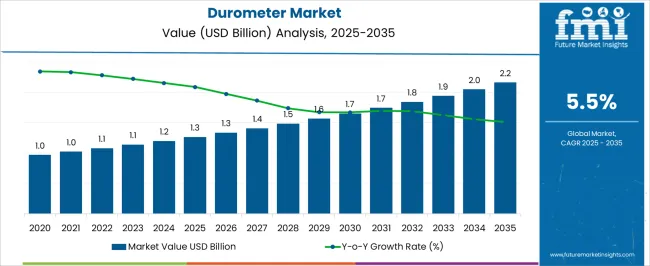
| Metric | Value |
|---|---|
| Durometer Market Estimated Value in (2025 E) | USD 1.3 billion |
| Durometer Market Forecast Value in (2035 F) | USD 2.2 billion |
| Forecast CAGR (2025 to 2035) | 5.5% |
The Durometer market is experiencing steady growth driven by the increasing demand for precise hardness measurement across multiple industries including manufacturing, automotive, and quality control laboratories. The current market scenario is shaped by the growing emphasis on product quality and compliance with international standards for material performance. In addition, the integration of advanced measurement technologies and automated systems is enabling more accurate and reliable hardness testing, which is influencing broader adoption.
The market is benefiting from rising investments in industrial automation and quality assurance infrastructure, particularly in emerging economies where industrial output is expanding rapidly. Future growth opportunities are expected to be driven by the development of multifunctional and user-friendly durometer solutions that provide digital readouts, data storage, and connectivity for analytics purposes.
Increasing awareness of the importance of material durability and performance, coupled with stricter regulatory standards, is expected to sustain the growth momentum As industries continue to prioritize quality control and material verification, the Durometer market is positioned for continued expansion across both established and emerging markets.
The durometer market is segmented by product type, operation, end user, material type, and geographic regions. By product type, durometer market is divided into Type A, Type B, Type C, Type D, Type M, Type E, and Others. In terms of operation, durometer market is classified into Mechanical Durometer and Digital Durometer. Based on end user, durometer market is segmented into Industrial and Laboratory. By material type, durometer market is segmented into Polymers, Elastomers, Acrylic Glass, and Others. Regionally, the durometer industry is classified into North America, Latin America, Western Europe, Eastern Europe, Balkan & Baltic Countries, Russia & Belarus, Central Asia, East Asia, South Asia & Pacific, and the Middle East & Africa.
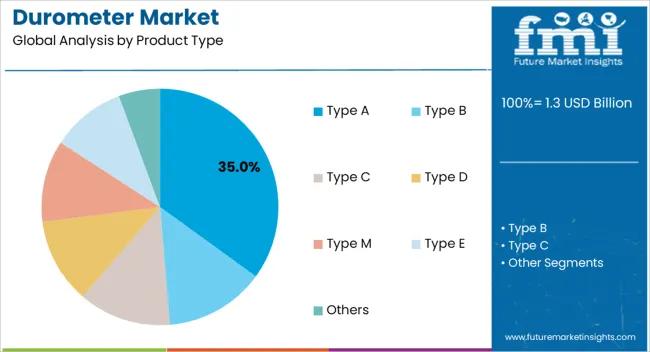
The Type A product type is projected to hold 35% of the Durometer market revenue in 2025, making it the leading product type. This dominance is attributed to its suitability for measuring the hardness of soft to medium materials, such as rubbers, elastomers, and polymers. The growth of this segment is supported by its widespread adoption in quality control laboratories and production lines, where accurate and repeatable measurements are essential.
The simplicity of use, durability, and consistency of Type A durometers have made them the preferred choice for routine hardness testing. Industrial manufacturers benefit from the cost-effectiveness and low maintenance requirements, enabling large-scale deployment without significant operational overhead.
The ability to deliver reliable results for a variety of materials and its adaptability to both manual and automated testing environments have further reinforced its leading position Continued innovation in digital enhancements, including data logging and connectivity, is expected to strengthen adoption and support the segment’s growth trajectory.
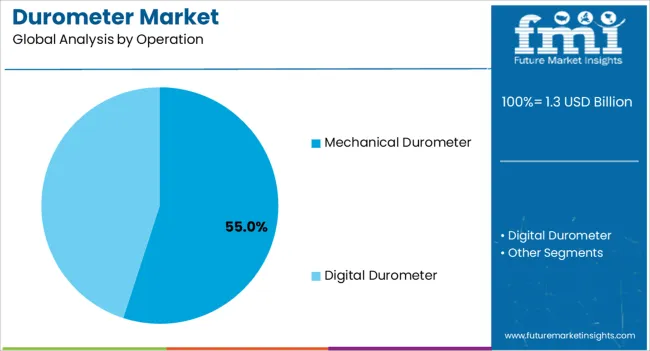
The mechanical operation segment is anticipated to account for 55% of total revenue in 2025, leading among operational types. This leadership is driven by the reliability, robustness, and ease of use provided by mechanical durometers in industrial and laboratory environments. Mechanical systems are favored where simplicity and durability are prioritized, as they require minimal calibration and are resistant to harsh operating conditions.
The segment has benefited from increasing use in production facilities for routine quality control, ensuring consistent material performance and compliance with manufacturing standards. Industrial users value the ability to quickly obtain hardness readings without dependence on digital power sources, enhancing operational flexibility.
The proven accuracy and longevity of mechanical durometers have facilitated widespread adoption, particularly in high-volume manufacturing contexts With ongoing focus on standardization and quality verification in industrial sectors, the mechanical durometer segment is expected to maintain its leading share and support the broader growth of the Durometer market.
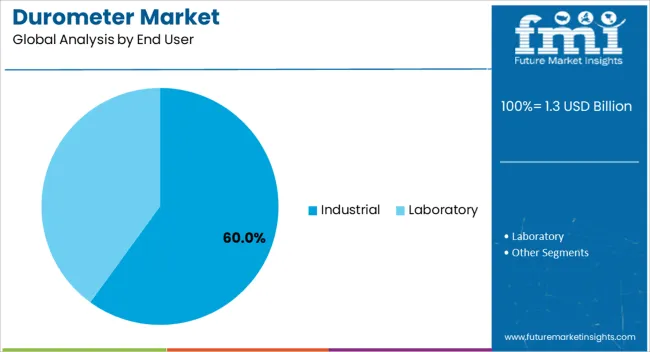
The industrial end-use segment is projected to hold 60% of the Durometer market revenue in 2025, establishing it as the largest end-user category. This prominence is being driven by the critical role of hardness testing in industrial manufacturing, including automotive, plastics, rubber, and metalworking applications. Industrial operations require reliable measurement of material properties to ensure product performance, durability, and regulatory compliance, which has fueled demand for durometer solutions.
The adoption of durometers in industrial settings has been facilitated by their adaptability to various materials, ease of integration into quality control processes, and ability to deliver repeatable and accurate measurements. Furthermore, the growing emphasis on industrial automation and precision manufacturing has reinforced the need for standardized hardness testing equipment.
The combination of durability, cost-effectiveness, and operational efficiency has positioned the industrial segment as the dominant consumer of durometer solutions As manufacturing and production activities expand globally, the demand from industrial users is expected to continue driving the market forward.
Durometer is a device which is used for the measurement of the hardness of material such as polymers, rubbers and elastomers. The higher number on the scale indicator, the greater resistance to the indentation and hence the material is said to be harder. The term used to denote the material’s rating on the scale is ‘Shore Durometer’.
Hence the durometers are also called as shore durometers owing to its popularity. Durometers are used to test the depressions of several different materials which are measured by the application of defined forces. The depth and deformation of the depressions show the hardness of the materials.
Durometers are used for hardness testing of different materials such as synthetic and natural rubber, elastic materials, acrylic glass, plastics, PVC, polyester, casting resin, neoprene, acetates, leather, fruits, hardboards and wood amongst others.
Different materials require different types of scales of hardness such as type A, type B, type C, etc. For instance, type A scale is used for the measurement of soft materials and plastics whereas the type D scale is used for the measurement of hard plastic materials.
The hardness measured by the durometers can be denoted in testing standards and units such as the Rockwell scale, Leeb rebound hardness level and Brinnell scale. Additionally, there are different type of scales for the measurement of thin and small materials or for the measurement samples with the help of durometers in the global market.
Presently, with the advancement of technologies the manufacturers have produced handheld, compact and digital durometers which are equipped internal memory to take automatic measurements with accuracy and in negligible time.
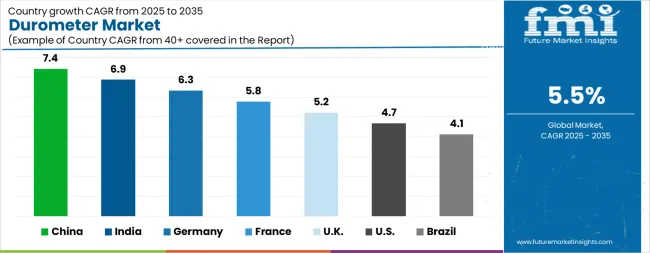
| Country | CAGR |
|---|---|
| China | 7.4% |
| India | 6.9% |
| Germany | 6.3% |
| France | 5.8% |
| UK | 5.2% |
| USA | 4.7% |
| Brazil | 4.1% |
The Durometer Market is expected to register a CAGR of 5.5% during the forecast period, exhibiting varied country level momentum. China leads with the highest CAGR of 7.4%, followed by India at 6.9%. Developed markets such as Germany, France, and the UK continue to expand steadily, while the USA is likely to grow at consistent rates. Brazil posts the lowest CAGR at 4.1%, yet still underscores a broadly positive trajectory for the global Durometer Market. In 2024, Germany held a dominant revenue in the Western Europe market and is expected to grow with a CAGR of 6.3%. The USA Durometer Market is estimated to be valued at USD 434.9 million in 2025 and is anticipated to reach a valuation of USD 686.7 million by 2035. Sales are projected to rise at a CAGR of 4.7% over the forecast period between 2025 and 2035. While Japan and South Korea markets are estimated to be valued at USD 69.3 million and USD 33.7 million respectively in 2025.
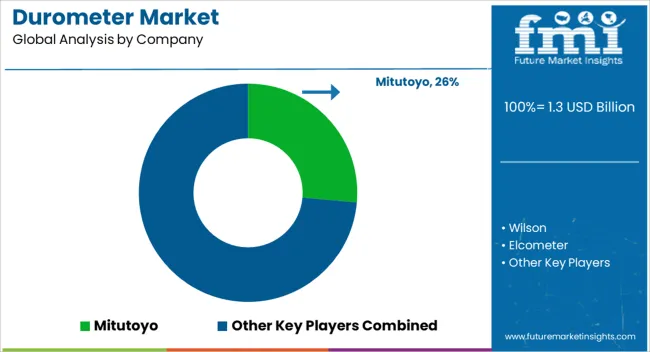
| Item | Value |
|---|---|
| Quantitative Units | USD 1.3 Billion |
| Product Type | Type A, Type B, Type C, Type D, Type M, Type E, and Others |
| Operation | Mechanical Durometer and Digital Durometer |
| End User | Industrial and Laboratory |
| Material Type | Polymers, Elastomers, Acrylic Glass, and Others |
| Regions Covered | North America, Europe, Asia-Pacific, Latin America, Middle East & Africa |
| Country Covered | United States, Canada, Germany, France, United Kingdom, China, Japan, India, Brazil, South Africa |
| Key Companies Profiled | Mitutoyo, Wilson, Elcometer, PCE Instruments, Zwick Roell, Fine, Akash Industries, Struers, Innovatest Europe BV, Shimadzu, and Chennai Metco |
The global durometer market is estimated to be valued at USD 1.3 billion in 2025.
The market size for the durometer market is projected to reach USD 2.2 billion by 2035.
The durometer market is expected to grow at a 5.5% CAGR between 2025 and 2035.
The key product types in durometer market are type a, type b, type c, type d, type m, type e and others.
In terms of operation, mechanical durometer segment to command 55.0% share in the durometer market in 2025.






Our Research Products

The "Full Research Suite" delivers actionable market intel, deep dives on markets or technologies, so clients act faster, cut risk, and unlock growth.

The Leaderboard benchmarks and ranks top vendors, classifying them as Established Leaders, Leading Challengers, or Disruptors & Challengers.

Locates where complements amplify value and substitutes erode it, forecasting net impact by horizon

We deliver granular, decision-grade intel: market sizing, 5-year forecasts, pricing, adoption, usage, revenue, and operational KPIs—plus competitor tracking, regulation, and value chains—across 60 countries broadly.

Spot the shifts before they hit your P&L. We track inflection points, adoption curves, pricing moves, and ecosystem plays to show where demand is heading, why it is changing, and what to do next across high-growth markets and disruptive tech

Real-time reads of user behavior. We track shifting priorities, perceptions of today’s and next-gen services, and provider experience, then pace how fast tech moves from trial to adoption, blending buyer, consumer, and channel inputs with social signals (#WhySwitch, #UX).

Partner with our analyst team to build a custom report designed around your business priorities. From analysing market trends to assessing competitors or crafting bespoke datasets, we tailor insights to your needs.
Supplier Intelligence
Discovery & Profiling
Capacity & Footprint
Performance & Risk
Compliance & Governance
Commercial Readiness
Who Supplies Whom
Scorecards & Shortlists
Playbooks & Docs
Category Intelligence
Definition & Scope
Demand & Use Cases
Cost Drivers
Market Structure
Supply Chain Map
Trade & Policy
Operating Norms
Deliverables
Buyer Intelligence
Account Basics
Spend & Scope
Procurement Model
Vendor Requirements
Terms & Policies
Entry Strategy
Pain Points & Triggers
Outputs
Pricing Analysis
Benchmarks
Trends
Should-Cost
Indexation
Landed Cost
Commercial Terms
Deliverables
Brand Analysis
Positioning & Value Prop
Share & Presence
Customer Evidence
Go-to-Market
Digital & Reputation
Compliance & Trust
KPIs & Gaps
Outputs
Full Research Suite comprises of:
Market outlook & trends analysis
Interviews & case studies
Strategic recommendations
Vendor profiles & capabilities analysis
5-year forecasts
8 regions and 60+ country-level data splits
Market segment data splits
12 months of continuous data updates
DELIVERED AS:
PDF EXCEL ONLINE

Thank you!
You will receive an email from our Business Development Manager. Please be sure to check your SPAM/JUNK folder too.
Chat With
MaRIA